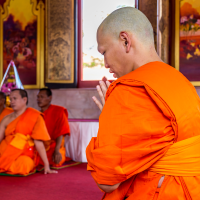Buddhist Mindfulness-Based Yoga
Description
Buddhist Mindfulness in Yoga is a comprehensive practice that combines physical postures, breathwork, meditation, and ethical principles to promote physical, mental, and spiritual well-being. It emphasizes being present in the moment, paying attention to sensations, thoughts, and emotions as they arise during practice. It has gained worldwide popularity not only as an exercise and relaxation technique but also as a means of personal growth and spiritual development. Yoga originated in ancient India, with evidence of its practice going back over 5,000 years. The earliest references to yoga are found in the Rig Veda, one of the oldest sacred texts in India, which mentions meditation and rituals.
Types of Yoga Exercise Training
-
Hatha Yoga
Often a gentle introduction to yoga, focusing on basic postures and breathing exercises. It's great for beginners.
-
Vinyasa Yoga
Known for its dynamic and flowing sequence of poses, synchronized with breath. It can be vigorous and is varied in pace and intensity.
-
Ashtanga Yoga
A physically challenging style involving a set series of poses performed in a specific order, promoting strength and endurance.
-
Iyengar Yoga
Emphasizes precise alignment and often utilizes props like blocks and straps. It is beneficial for building strength, flexibility, and balance.
-
Bikram Yoga
Consists of a specific sequence of 26 postures and two breathing exercises practiced in a heated room.
-
Kundalini Yoga
Combines postures, breathwork, chanting, and meditation in a specific sequence to awaken the kundalini energy believed to reside at the base of the spine.
-
Yin Yoga
A slower-paced practice with poses held for longer periods, targeting deep connective tissues and promoting relaxation.
-
Restorative Yoga
Focuses on relaxation and recovery, using props to support the body in restful poses.
-
Power Yoga
A vigorous, fitness-based approach to Vinyasa. It's fun, energizing, and often practiced at a faster pace.
-
Mindfulness-Based Yoga Mindful Yoga
Integrates mindfulness and yoga, focusing on awareness of body, breath, and mind. Often taught with an emphasis on meditation and present-moment awareness.
-
Integrated Yoga Therapy
Combines yoga practices with mindfulness and therapeutic techniques to address psychological and physical well-being.
-
Trauma-Sensitive Yoga
Adapts traditional yoga practices to create a supportive environment for trauma survivors, incorporating mindfulness and awareness strategies.
-
Yoga Nidra
A deep relaxation technique and guided meditation practice aiming for a conscious state between waking and sleeping.
-
Kripalu Yoga
Encourages inner awareness and compassion through mindful movement and self-observation.
-
Sivananda Yoga
Based on the teachings of Swami Sivananda, emphasizing five main points of yoga: proper exercise, breathing, relaxation, diet, and positive thinking.
Key Elements and Benefits of Mindfulness-Based Yoga
Hiring For A Specific Role
Discover Out Expert Skillsets

Buddhist Mindfulness Meditation
Buddhist mindfulness meditation, also known as "vipassana" or "insight meditation," offers numerous benefits that can enhance daily life. Integrating mindfulness meditation into your routine can lead to significant positive changes in how you experience and interact with the world, be it through better mental and physical health or healthier relationships. Consistent practice leads to transformative shifts in personal well-being and quality of life. These meditative practices can be adapted and personalized according to individual needs and preferences. Different schools of Buddhism emphasize various practices and techniques, but all share the common goal of fostering mindfulness, concentration, and insight. These practices focus on cultivating sustained attention on present moment experiences, aiding practitioners in developing a deep, reflective awareness that permeates their everyday lives. While the specific techniques may vary, the underlying principle is to nurture mindfulness, helping practitioners to live more consciously and be more fully aware of their present experience.

Buddhist Counseling Therapy
Buddhist-based Counseling Therapy draws on Buddhist philosophy and practices to support individuals dealing with mental and emotional challenges such as emotional instability, major depression, social anxiety disorders, post-traumatic stress disorder and autism spectrum disorder. This approach offers unique insights and tools by integrating mindfulness, meditation, and Buddhist teachings with modern therapeutic techniques. Here’s an overview of how Buddhist principles can be applied to enhance therapy for these conditions, offer a holistic approach to mental and emotional well-being. Offering valuable insights and tools that complement traditional therapeutic techniques. It can provide individuals with meaningful pathways to reducing suffering and achieving inner peace. Emotional Instability. By leveraging teachings centered on mindfulness, compassion, and non attachment, clients can find meaningful avenues for reducing suffering and promoting inner peace. This integrated approach empowers individuals to perceive experiences with a balanced perspective, effectively navigate their challenges, and move towards enriched emotional and psychological well-being.

Buddhist Cognitive-Behavioral Therapy
Buddhist Faith-Based Cognitive-Behavioral Therapy (BF-CBT) is an approach that integrates principles from both Cognitive-Behavioral Therapy (CBT) and Buddhist philosophy to treat addiction and substance abuse, including alcohol addiction. It leverages Buddhist concepts such as mindfulness, impermanence, non-attachment, and the middle path to complement traditional CBT techniques. Core Principles Mindfulness. This involves developing an awareness of the present moment and helping individuals observe their thoughts and emotions without judgment. It teaches clients to recognize cravings and triggers as transient experiences that can be managed without immediate reaction. Impermanence. This Buddhist concept helps clients understand that cravings and urges are temporary and will pass if they avoid reacting impulsively to them.

Buddhist Special Occasions Ceremonies
Buddhist prayer ceremonies are deeply rooted in tradition and are designed to honor, bless, and celebrate special occasions such as weddings, grand openings, and other significant life events. These ceremonies often integrate various elements of Buddhist practice, including chanting, offering, and meditation, to invoke blessings and auspiciousness. General Structure of a Buddhist Prayer Ceremony. Environment. The location is often adorned with symbols of good fortune like images of the Buddha, flowers, candles, and incense. Participants usually dress in traditional or respectfully formal attire. Guests assemble at the location, preparing themselves by calming their minds and setting positive intentions. The ceremony typically begins with lighting incense, a practice meant to purify the space. Participants may engage in bows or prostrations to show respect to the Buddha, Dharma (teachings), and Sangha (community).

Buddhist Chaplain Prayer Ceremony
Buddhist Prayer Ceremonies, integral to various traditions of Buddhism, often include a combination of elements such as chanting, meditation, and the recitation of sutras. These practices are designed to foster spiritual connection, wisdom, and compassion. Chanting is a form of verbal prayer used to focus the mind, express devotion, and invoke the presence of Buddhas and Bodhisattvas. Meditation integrated into ceremonies to deepen mindfulness and inner reflection. It might also be used to generate loving-kindness. Prayer teachings and cultivate virtues like compassion and understanding. The Heart Sutra, Diamond Sutra, or the Lotus Sutra, each carrying profound teachings on emptiness and enlightenment. Mantras are sacred syllables or phrases believed to carry spiritual power. Example. "Om Mani Padme Hum" is a prominent mantra associated with Avalokiteshvara. This mantra is especially popular in Tibetan Buddhism and symbolizes wisdom and compassion.
Yo!Gigs For Talents
Are you a candidate Looking for work?
There's never been a better time to take yourself online and start making money from your very own fine-tuned set of skills.


